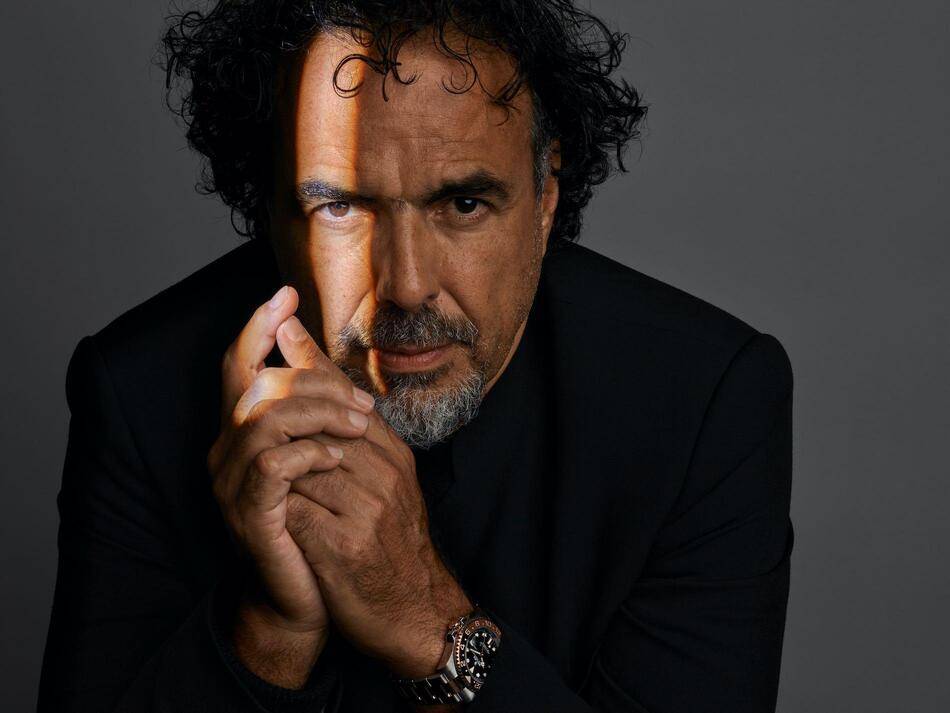Many of the films made by acclaimed Mexican auteur and Alejandro G. Iñárritu involve individuals wronging one another — in some cases, fatally. Conversely, in his own life, Iñárritu has been fortunate enough to encounter a number of people who've helped elevate him to his present position among Hollywood's most respected, sought-after directors.
Helming movies that have garnered 45 Academy Award nominations and himself winning 2 Oscars for Best Director, the Rolex Testimonee's humility and deep sense of appreciation for his mentors, collaborators and mentees come to the forefront.

Rolex Testimonee Alejandro G. Iñárritu and his GMT-Master II
His Oyster Perpetual GMT-Master II
in Everose Rolesor with an Oyster bracelet
features a black dial and a brown and black Cerachrom bezel.
Designed to show the time in two different time zones
simultaneously during intercontinental flights,
the GMT-Master has come to be recognized
for its robustness and versatile appearance. Find out more.
Having left school at the age of 16, Iñárritu took a job on a cargo ship that sailed across the Atlantic and up the Mississippi River. The experience gave him his first encounters with culture cultures, but also drove home the importance of receiving a complete education to broaden his career opportunities.
At the Ibero-American University in Mexico City, Iñárritu met Mexican author, screenwriter, director and producer Guillermo Arriaga, who also happened to be a professor at the college. The two would subsequently collaborate on the so-called 'Death Trilogy' of films that established Iñárritu’s reputation — Amores Perros (2000), 21 Grams (2003), and multilingual film Babel (2006) — all three of which were written by Arriaga.
Before embarking on what was to become a prolific filmmaking career, Iñárritu was mentored for a number of years by Ludwik Margules, a Polish-born impresario who was a prominent figure in Mexican theatre for several decades. In an interview with Rolex, Iñárritu said Margules "taught me to always question myself and to embrace uncertainty as part of the process. He transformed my perception of what it was like to be a director. I had jumped to a conclusion of what directing was like, but I didn't have the real perception, the deep knowledge, the consciousness."
Instruction from Margules, Iñárritu said, gave him "the self-confidence to answer my own questions without fear, and with humility and veneration for the art. I don’t think it’s possible for a teacher to tell you that. A teacher gives you knowledge, but wisdom is something else. He filled me with a passion for human drama, to the dramaturgy of being able to represent human nature in the art of filmmaking."

In the '90s, Iñárritu met and was encouraged by more established Mexican filmmakers Guillermo del Toro and Alfonso Cuarón. The pair helped Iñárritu bring together an enviable team when making his 2000 debut, Amores Perros, including cinematographer Rodrigo Prieto (who'd go on to work as director of photography for Ang Lee, Oliver Stone and Martin Scorsese), composer Gustavo Santaolalla, sound designer Martin Hernandez and production designer Brigitte Broch. Several of them became long-term collaborators with Iñárritu.
The director became involved in the Rolex Mentor and Protégé Arts Initiative around the time he was preparing for the release of dark comedy Birdman (2014), which received 9 Academy Award nominations, winning 3 Oscars for himself, including Best Picture, Best Director and Best Original Screenplay.
Iñárritu selected young Israeli director Tom Shoval as his protégé, inviting the aspiring filmmaker on the set of The Revenant (2015), the visceral western that would eventually win Iñárritu another Oscar for Best Director.
Shoval later wrote a diary of this incredible year-long experience: "Alejandro offers me the opportunity to follow the shoot from his point of view. Such generosity allows me to witness all stages of preparation and watch him make decisions in real time, working the set and the actors. There is no better film school than this." Sitting at Iñárritu’s elbow, with Leonardo Di Caprio at their side, reviewing the day’s footage, is the aspiring cineaste's "boyhood dream come true."
Awestruck in the company of Iñárritu, his star-studded cast and Oscar-winning crew, Shoval wrote, "I take a step back and wonder how this production, with a budget of tens of millions of dollars, could teach me anything. This is nothing like anything I’m used to in my country. But the truth is, just watching Iñárritu work — he is a total filmmaker — I understand that film has nothing to do with the size of the canvas at your disposal. Thanks to Iñárritu, I relearn this truth about film: it always takes place in the space between one movement as it connects to another, creating a shock of emotion."

In Iñárritu’s opinion, mentoring is only partly about teaching the technical aspects of a discipline. The other part, Iñárritu said, is about being "someone who helps you see something within yourself, something that you had not seen and who gives you the confidence to carry it out, even if you think you don’t know it. When you are able to express your human experience and translate it into images that reveal to you who you are, that is already poetic. We all have that ability, we just need someone to discover us."
Discover more on Rolex.org


















